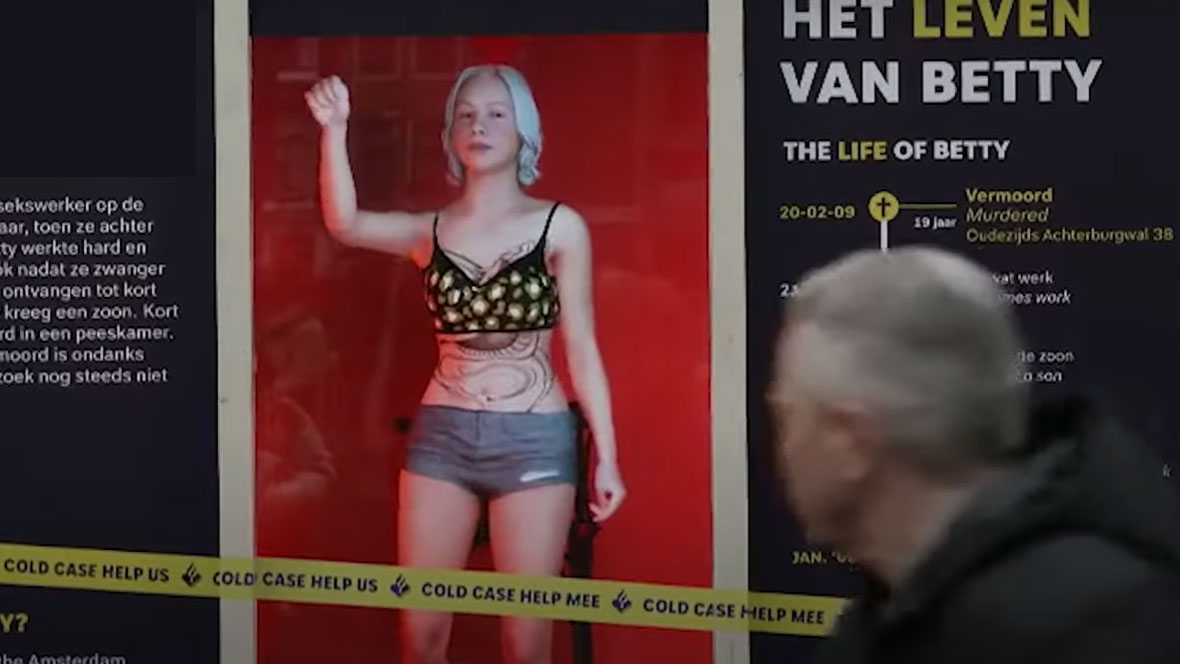3D hologram of sex worker created by Dutch police could help solve her cold case murder
Betty Szabo was murdered in 2009, and now police are hoping a public hologram of her will help catch the killer

She was murdered at age 19, but now the hologram of Betty Szabo haunts the red light district in Amsterdam, the Netherlands.
Dressed in grey heels, denim shorts and a leopard print bra, with a tattoo of a dragon trailing up her torso, the hologram eerily leans forward and appears to knock on the window, attracting the attention of passers by.
She then breathes on the glass, and in the mist writes the word “help.”
Dutch police created the holographic representation (which you can view further down this article) using 3D visualization technology, in a first for the force.

Hungarian-born Bernadette “Betty” Szabo was murdered in 2009, a few months after giving birth. She was working as a sex worker at the time.
The Dutch police describe Szabó as being from Nyíregyháza, in the “poor northeastern part of Hungary. She and her family live in poverty. Despite the sometimes difficult circumstances and limited opportunities, she does well in school. She spends her free time gardening and playing her violin, which earns her several prizes.”
According to the BBC, in the early hours of February 19 2009, a pair of sex workers went to check on Szabo during a break, and realized that her usual music was not playing. When they went into her small brothel room, which consisted of a plastic-covered bed, a table and a sink, they found her body lying in a pool of blood.
Get the Digital Camera World Newsletter
The best camera deals, reviews, product advice, and unmissable photography news, direct to your inbox!
The BBC reported that she had been murdered three months after giving birth in a savage knife attack, and that her baby was placed in care, a factor that “motivates detectives.”
As well as the hologram, the police also set up screens displaying text about Szabó, her background, and death, with accompanying images and a documentary about her case.
ABOVE: Watch the Euronews report
Despite the innovative nature of police attempts to solve this cold case, the hologram campaign does propose potential ethical dilemmas.
The police force says it contacted Szabó’s relatives before producing the hologram, but it is not clear whether Szabó’s child (who would now be approximately 15) is aware of their mother's identity, or whether they still reside in the Netherlands.
There could be an argument that, in either circumstance, significant distress could be caused if the child were to see this visualization on social media, or if they find out through the global reporting of this story the identity of their mother, and the circumstances of her death.
“This is the first time we do something like this and, to be honest, we’re a bit nervous,” Benjamin van Gogh, coordinator of the Dutch police’s Amsterdam Wanted and Missing Persons Team, said in a news release. “We want to do justice to Betty, to her family and friends, and to the case.”
Police are offering €30,000 (approximately $30,600 / £25,000 / AU$49,000) to anyone with any information.

After graduating from Cardiff University with an Master's Degree in Journalism, Media and Communications Leonie developed a love of photography after taking a year out to travel around the world.
While visiting countries such as Mongolia, Kazakhstan, Bangladesh and Ukraine with her trusty Nikon, Leonie learned how to capture the beauty of these inspiring places, and her photography has accompanied her various freelance travel features.
As well as travel photography Leonie also has a passion for wildlife photography both in the UK and abroad.
